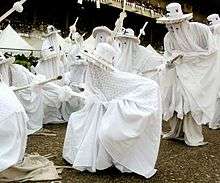Olokun
| Olokun | |
|---|---|
| Member of Orisha | |
| Other names | Olocún |
| Venerated in | Yoruba religion, Candomble, Santeria |
| Region | Nigeria, Benin, Brazil |
| Ethnic group | Yoruba people |
Olokun (Yoruba: Olókun, known as Olocún in Latin America) is an orisha. Olokun is believed to be the parent of Aje, the orisha of great wealth and of the bottom of the ocean. Olokun is revered as the ruler of all bodies of water and for the authority over other water deities. Olokun is highly praised for her or his ability to give great wealth, health and prosperity to her or his followers. Communities in both West Africa and the African diaspora view Olokun variously as female, male, or androgynous.[1][2][3]
West Africa

Water deities are "ubiquitous and vitally important in southern Nigeria"[4]; Olókun worship is especially noted in the cities of the Edo people in southwest Nigeria. In West African areas directly adjacent to the coast, Olokun takes a male form among his worshipers, while in the hinterland, Olokun is a female deity.[2]
Candomblé
In the Candomblé religion of Brazil, Olokun is venerated as the mother of Yemoja and the owner of the sea. She is recognized in Candomblé terreiros, but not during celebrations. In this respect, Olokun is similar to Odudua and Orunmilá; they held great importance in West Africa but play a minor role in Afro-Brazilian religion. There are no xirê chants dedicated to Olokun as with other orixás. Candomblé initiates recognize the divinity of Olokun but do not hold her as a personal deity. The veneration of Olokun has been revived in the late 20th and early 21st century through visits to Brazil by West African priests.[5]
Olokun is celebrated during the Festival of Yemoja (Festa de Iemanjá).
Santería
Olokun is an orisha in the religion of Santería. Olokun is an androgynous orisha, meaning Olokun is a man and a woman, depending on if it is the Olokun of Ifá, or the Olokun of Ocha.[2]
Pataki
According to The Book Of Ifá' (? no such book ?)', Olokun became enraged and rose to the surface. As Olokun did this to drown the humans, the orishas went to Orunmila to ask him what to do. Orunmila told them that Ogun needed to create the longest chain he can possibly create. It was ultimately Obatala who had the responsibility of imprisoning Olokun in her/his domain. Knowing this, Obatala went to Ogun and asked him to make the longest chain he had ever made, and so he did. Obatala then went down into the ocean and trapped Olokun with the chain.
References
- ↑ Adeoye, C. L. (1989). Ìgbàgbọ́ àti ẹ̀sìn Yorùba (in Yoruba). Ibadan: Evans Bros. Nigeria Publishers. pp. 227–236. ISBN 9781675098.
- 1 2 3 Clark, Mary Ann (2007). Santería : correcting the myths and uncovering the realities of a growing religion. Westport, Conn.: Praeger Publishers. p. 62. ISBN 978-0-275-99079-4.
- ↑ Harvey, Marcus (2015). "Engaging the Orisa: An Exploration of the Yoruba Concepts of Ibeji and Olokun as Theoretical Principles in Black Theology". Black Theology. 6 (1): 61–82. doi:10.1558/blth2008v6i1.61. ISSN 1476-9948.
- ↑ Murphy, Joseph (2001). Ọ̀ṣun across the waters: a Yoruba goddess in Africa and the Americas. Bloomington: Indiana University Press. p. 238. ISBN 9780253108630.
- ↑ Silva, Marcel Franco da (2012). "A polissemia do sagrado em do amor e outros demônios de Gabriel García Márquez". INTERAÇÕES: Cultura e Comunidade. 7 (12): 69–90.